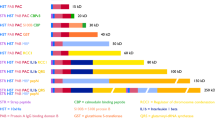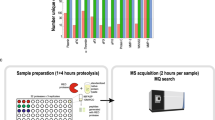Abstract
SAMPLES of human plasminogen, prepared according to the method of Kline1, have been subjected to ultracentrifugal analysis2. The patterns observed contained two sedimenting peaks. The slower peak constituted approximately 70 per cent of the total area and had a sedimentation constant, s 20,w, of 4.28 S, extrapolated to infinite dilution. The faster peak, which was much broader and resolved poorly from the main component, had a sedimentation constant of about 7–10 S. It was merely assumed that plasminogen was to be identified with the 4.3 S-component, and on this basis, along with other data, molecular size and shape were estimated. We now report direct evidence to substantiate this assumption.
This is a preview of subscription content, access via your institution
Access options
Subscribe to this journal
Receive 51 print issues and online access
$199.00 per year
only $3.90 per issue
Buy this article
- Purchase on Springer Link
- Instant access to full article PDF
Prices may be subject to local taxes which are calculated during checkout
Similar content being viewed by others
References
Kline, D. L., J. Biol. Chem., 204, 949 (1953).
Shulman, S., Alkjaersig, N., and Sherry, S., J. Biol. Chem., 233, 91 (1958).
Remmert, L. F., and Cohen, P. P., J. Biol. Chem., 181, 431 (1949).
Author information
Authors and Affiliations
Rights and permissions
About this article
Cite this article
SHULMAN, S. Identification of Ultracentrifugal Components in Human Plasminogen Preparations. Nature 188, 161–162 (1960). https://doi.org/10.1038/188161b0
Issue Date:
DOI: https://doi.org/10.1038/188161b0
Comments
By submitting a comment you agree to abide by our Terms and Community Guidelines. If you find something abusive or that does not comply with our terms or guidelines please flag it as inappropriate.



